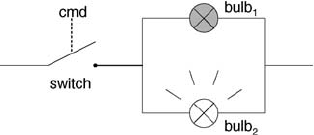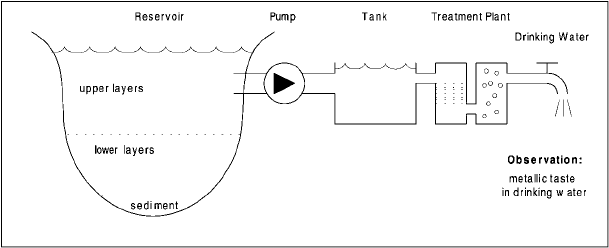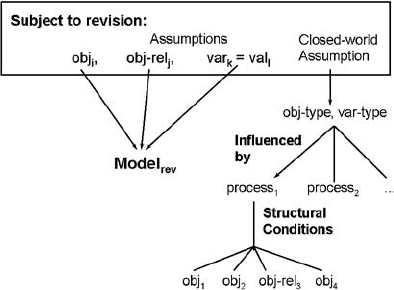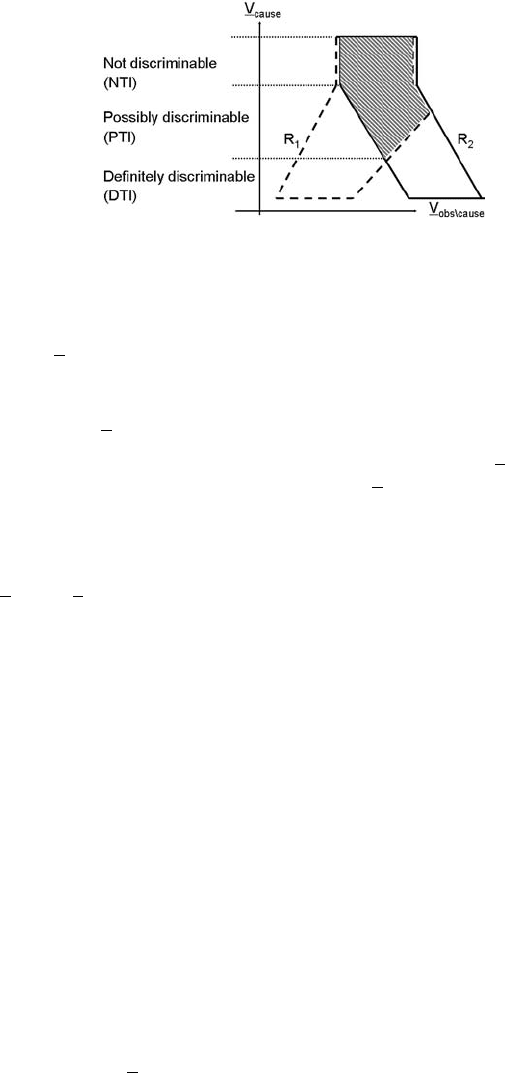Van Harmelen F., Lifschitz V., Porter B. Handbook of Knowledge Representation
Подождите немного. Документ загружается.


432 10. Model-based Problem Solving
Figure 10.5: A fragment of a circuit with two parallel light bulbs.
some symptoms, we may want a diagnosis that provides a causal account for them.
This idea leads to a new logical definition of a diagnosis, which requires that a model
logically entails the givenobservations, rather than simply being consistentwith them:
MODEL OBS
[57]. However, we have to be cautious when using this definition of abductive diagno-
sis. For instance, if the observations include a command “CLOSE” to the switch in the
fragment of a circuit shown in Fig. 10.5,butbulb
1
remains dark while bulb
2
is lit, then
the single fault in bulb
1
explains the observations of the bulbs, but we do not expect
it could provide a reason for switch.cmd = CLOSE. Intuitively, we want the system
response (the “output” variables) to be entailed, but not the exogenous features (the
“input” or independent variables). The most general definition reflecting this intention
is the following.
Definition 10.14 (Abductive diagnosis). Let MODEL
F
be a model of a fault and
OBS = OBS
C
∪ OBS
A
be a set of observations. MODEL
F
is an abductive diagnosis
iff it is consistent with OBS
C
and entails OBS
A
:
MODEL
F
∪ OBS
C
⊥,
MODEL
F
∪ OBS
C
OBS
A
.
A complete mode assignment MA is a component-oriented abductive diagnosis for a
system description SD and a set of observations OBS iff
SD ∪{MA}∪OBS
C
⊥,
SD ∪{MA}∪OBS
C
OBS
A
.
Please, note that if OBS
C
refers to exogenous variables, the first condition is sat-
isfied by any valid model (as discussed in Section 10.3). Console and Torasso [9]
discuss the consequences of different possibilities to specify OBS
C
and OBS
A
. In our
example, we would choose
OBS
C
={switch.cmd = CLOSE},
OBS
A
={bulb
1
.light = OFF, bulb
2
.light = ON}.
Unfortunately, a single fault in bulb
1
does not entail OBS
A
based on OBS
C
, because
there is no information about the voltage supply and is not found as an abductive
diagnosis, unless also the voltage supply is abduced.
P. Struss 433
Poole [57] raises the issue of how to represent the observations. Rather than treat-
ing them as a conjunction of inputs and outputs, we could try to find an explanation
for observations stating that the input implies the output. This means in our example,
we use
OBS ={switch.cmd = CLOSE ⇒ (bulb
1
.light = OFF ∧ bulb
2
.light = ON)}
which would have to be entailed by an abductive diagnosis (which is again not the
case). Note that we (humans) can even obtain a diagnosis solely based on observation
of the outputs:
OBS ={bulb
1
.light = OFF, bulb
2
.light = ON}
and that consistency-based diagnosis with fault models produces the proper result.
Abductive diagnosis is attractive, because it provides a stronger notion of diagnosis
which seems to reflect the aspect of causality in our human conception of diagnosis.
However, apart from the fact that logical entailment is generally unrelated to causal-
ity, this stronger notion of diagnosis imposes stronger requirements on the model
and the possible inferences, as illustrated by the above example. When compared to
consistency-based diagnosis, the results are more sensitive to the particular represen-
tation and strength of the model and the observations. If an observation states that,
say, a flow at some point is positive, while a model can only predict a disjunction
flow = zero∨ flow = positive (e.g., based on the model of a check valve), it would not
be an abductive diagnosis. If the domain of flow (both in the model and the observa-
tion) would contain only the values negative and non-negative, then this would yield
an abductive diagnosis. However, this coarser domain may then be too weak to derive
some other predictions.
Of course, consistency-based diagnosis depends on the strength of the model, as
well, and, in particular, on the granularity of the domains. This is because this can
render the model unable to detect some of the existing conflicts. However, it is still
guaranteed that the correct diagnosis (as a mode assignment) is never excluded. Such
a guarantee cannot be obtained for abductive diagnosis.
Depending on the available observations, an abductive diagnosis may include not
only the modes, but also the current state of the system and even numerical parameters
(as suggested by [57]) which makes the abduction task even harder for systems of an
interesting kind and size.
Abductive diagnosis seems to become feasible and provide some basis for meet-
ing our intuition behind an explanation, if the model has causal notion embedded (as
opposed to purely constraint- or equation-based behavior descriptions). In fact, many
of the examples used for explaining abductive techniques come as causal networks
that explicitly link faults to effects. As already discussed in Section 10.3,thiskind
of system-specific diagnosis task compiled into a system model is a non-solution to
diagnostic applications (although in engineering practice, something similar is done
in constructing fault trees for safety analysis), because it violates genericity, com-
positionality, and reusability of the model. What is required is a modeling ontology
that captures causality and is compositional. As stated earlier, process-oriented mod-
eling [34, 35, 41] is a candidate. This also paves a way to overcome some of the
restrictive assumptions and limitations of component-oriented diagnosis discussed in
Section 10.4.1.

434 10. Model-based Problem Solving
Figure 10.6: The drinking water has a high iron concentration, because solid iron in the sediment was
re-dissolved into the water and transported to the tap.
10.4.6 Process-Oriented Diagnosis
In a simplified (though real) scenario of drinking water treatment (Fig. 10.6) [41],
a high concentration of dissolved iron is detected in the drinking water. Since it ex-
ceeds the legally allowed level, and there is no source of iron the operators are aware
of, this is a challenge for diagnosis. Human analysis yields to the following result:
there is solid iron in the sediment of the reservoir, which was not known before. When
the pH of the lower water layer, which is usually neutral, became acidic (most likely
caused by some algal bloom phenomenon), this started a chemical process of redis-
solving of iron into the water body. The dissolved iron ascended to the surface layers,
was captured with the raw water intake, and the treatment process did not reduce the
unexpectedly high concentrations of iron as required. While we would claim that the
case is clearly a diagnostic task, let us revisit the assumptions underlying component-
oriented diagnosis as discussed in Section 10.4.1.
• Fixed, well-specified set of components: although there are components, such
as pumps, containers, etc., the relevant diagnostic reasoning refers to biological,
chemical, and physical processes; it would not be convenient to consider algae,
water layers, etc. as components, and even if we do, solid iron was not a known
“component” of the system.
• Known, fixed structure: the system and its model does not have a static struc-
ture; rather, there is a dynamically changing pattern of active processes and
objects, substances, etc. appearing and disappearing.
• Well-designed system: although the treatment plant itself could be considered
as such, the notion makes no sense for the reservoir and the processes involved.
The GOALS are external to the model, and without making them explicit, there
is no inconsistency.
• Component faults only: obviously, algae are not a fault, even if their biomass
grows exponentially in an algal bloom period, nor is redissolving of iron un-
der acidic conditions a fault mode of something; it is simply natural. But it is
unwanted from the perspective of the violated GOALS.

P. Struss 435
• No structural faults: the nature of the disturbance is a structural change in the
system, triggering unforeseen processes.
• “Crisp” faults: even more than with respect to artifacts, healthiness of ecologi-
cal and biological systems, but also process plants is often expressed in terms of
a spectrum of degradation, rather than a qualitative behavior change. Of course,
in our example, the legal restrictions make it crisp.
Obviously, addressing such a diagnosis task in theory and implementation requires a
different formalization of modeling and the diagnosis task. However, what we stick
with is the idea that the answer to the diagnosis task is given by a model that is “com-
pliant” with the observations of system behavior.
The example suggests the use of process-oriented modeling. Collins [7] develops
the Process Diagnosis Engine (PDE) as abductive diagnosis on such a model. Heller
and Struss [41] present a theory of process-oriented consistency-based diagnosis, re-
alized as the Generalized Diagnosis Engine (G
+
DE).
In a nutshell (see [34, 35, 41] for details), a process is considered as some elemen-
tary phenomenon, which can be modeled independently of others and is, therefore,
suited to compositional modeling. This has two consequences: one is that a process
model has to state explicitly all preconditions for the process to occur by listing the
(typed) objects that interact in a particular configuration (structural-conditions) and
constraints on involved quantities (quantity-conditions). A process can create new
objects and relations between them (structural-effects) and affects quantities of the
participating objects (quantity-effects). The second consequence of the required com-
positionality is that quantity-effects cannot all be simply stated as constraints on the
quantities. This is because each (type of) process can only state a partial contribution
to some overall effect. For instance, the model of the iron-redissolving process can
only state that it adds to the concentration of dissolved iron in the water layer, but it
cannot claim that this concentration effectively increases, because in a particular sce-
nario, there may be other, counteracting, processes active that override the effect (e.g.,
oxidation of iron). In response to this, process-oriented modeling involves the concept
of influences that goes beyond mathematical modeling based on (differential) equa-
tions, constraints, or first order logic. If some variable x influences a variable y,say,
positively, written I
+
(x, y), this means basically that the derivative of y is a monotonic
function of x:
I
+
(x, y) ⇔∃f
dy
dt
= f(...,x,...)∧
df
dx
> 0.
The actual value of
dy
dt
can only be determined after all existing influences can be (e.g.,
linearly) combined. But this requires a closed-world assumption, which provides an
important hook for model revision during the search for a consistent model.
Thus, a process implies the effects, if the conditions are true:
structural-conditions ∧ quantity-conditions
⇒ structural-effects ∧ quantity-effects
How can we state the diagnosis problem, which we call situation assessment, because
there is not necessarily “something wrong”? We start with a partial description of a
436 10. Model-based Problem Solving
scenario in terms of objects, object relations, and variable values. This may include
real observations, OBS (e.g., measurements, such as “iron concentration above thresh-
old”) and assumptions, ASSM (e.g., assertions that usually hold, such as “pH neutral”).
The target is to construct process models that, based on propositions about structure
(objects and object relations) and quantities, are consistent with OBS and, if possi-
ble, with ASSM. Again, we apply Occam’s razor and prefer models that satisfy some
minimality criteria. There are two orthogonal dimensions:
• do not drop more assumptions than required to obtain a consistent model,
• do not introduce more unanticipated objects than necessary in order to derive an
explanation (why assume both solid iron in the sediment and iron in an affluent
to the reservoir?): the structural basis should not be larger than necessary.
We should be more precise about the latter criterion: what we would like to minimize
is the set of objects in the model that are not generated by some process, but are intro-
duced without further justification by the model. In our example, the dissolved iron is
an effect of the redissolving process, whereas the solid iron in the sediment does not
have an explanation in the model. Hence, the issue relates to the question of the model
boundaries: where should we stop to ask for reasons, because they are beyond what
is captured by the model library? In our case, iron in the tank requires a causal ex-
planation, whereas the existence of solid iron or algae does not. We characterize those
types of object that sit “on the boundary” of the model as introducible. Obviously, they
comprise those that never occur as a structural effect of a process in the library. But we
may want to regards additional ones as introducible for certain problems or scenarios.
Based on this, we can give an informal definition of a process-oriented diagnosis
(a formal account using default logic is described in [40]).
Definition 10.15 (Situation assessment). Let LIB be a process library, OBJ-INTRO
the set of introducible objects, OBJ-OBS and OBJ-ASSM the objects mentioned in
OBS and ASSM, respectively. A situation assessment for (LIB, OBS, ASSM) is a triple
(STRUCTURE, QUANT, ASSM-RETR); where STRUCTURE is a set of objects, and
relations, QUANT is a set of value assignments to quantities, and ASSM-RETR ⊂
ASSM a set of assumptions such that the resulting model is consistent with the obser-
vations and a subset of the assumptions:
(i) STRUCTURE ∪ QUANT ∪ LIB ∪ OBS ∪ (ASSM \ ASSM-RETR) ⊥
The structure contains the observed objects and a subset of the assumed ones:
(ii) OBJ-OBS ⊂ STRUCTURE,
OBJ-ASSM \ ASSM
-RETR ⊂ STRUCTURE,
(iii) the model contains exactly the objects that are entailed by the introducible
objects, i.e. the introducibles themselves and the ones created by processes,
(iv) (STRUCTURE ∩ OBJ-INTRO) ∪ ASSM-RETR is a (with respect to set inclu-
sion) minimal set that satisfies (i) through (iii).
Different applications may require modifications to this definition which mini-
mizes the set of newly introduced objects and retracted assumptions, while introduced

P. Struss 437
Figure 10.7: The options for model revisions.
relations do not count. Also, the likelihood of the occurrence of objects may further
constrain the focus.
Regardingthe implementation of a process-oriented diagnosis system, condition (i)
suggests that algorithms from component-oriented consistency-based diagnosis can be
applied: conflicts can be generated that contain user assumptions from ASSM and the
closed world assumptions underlying the influence resolution for quantities. We point
out that the latter introduce an element of abductive diagnosis: influence resolution
implies that the derivative of a variable is zero if there is no influence acting on this
variable.Therefore, if a change in a variable is observed (or postulated), any model that
contains no process influencing this variable will be inconsistent, and the closed-world
assumption for this variable occurs in a conflict. The same happens, of course, if the
knowninfluences contradict the (direction of) change in a variable. A similar technique
can be used, if the deviation of some variable from an expected value is observed and
the model captures how such deviations can emerge and propagate through a system.
Resolving such conflicts and revising the model in a search process starts from the
retraction of these closed-world assumptions. While in component-oriented diagnosis
retraction of a mode assumption means switching to a different mode, retraction of
the closed-world assumption requires to find (additional) potential influences on this
variable. The search space for this revision is given by the process library: it contains
a finite set of processes that can possibly influence a variable of the respective type
associated with an object ofthe respective type. Extending the model by such a process
may lead to a new inconsistency, if its quantity conditions are not satisfied. Also, the
structural conditions need to be satisfied, and if they contain objects that are not yet
included in the model, then condition (iii) requires that they either be introducible or
explained by the structural effect of yet another process to be included. Also for this
revision, the processes in the library can be searched for the appropriate candidates.
Fig. 10.7 illustrates the search process. Compared to the component-oriented best-first
search algorithms, the minimality criterion is less effective in this case, because it
relates to the ultimate cause (the introducible objects), and a one-step look-ahead will
not help.
438 10. Model-based Problem Solving
The existing approaches along these lines (PDE [7], G
+
DE [41]) are performing
diagnosis in one snapshot. This is a serious limitation for many relevant diagnosis
problems, since the origin of some disturbance may already have ceased to exist, while
the effects persist. For instance, if we expect to detect a cause for the deviation in the
pH (e.g., algal bloom), the actual observation may state that there is none and render
such an explanation inconsistent.
Including the temporal dimension adds to the complexity issues of this approach
and, together with the demand for good search heuristics makes it a real challenge
to model-based diagnosis research. Any progress would contribute to a significant
extension of the application scope of model-based diagnosis.
10.4.7 Model-based Diagnosis in Control Engineering
There exists another research area also called “model-based fault diagnosis and isola-
tion”. It has emerged in control engineering, and, while sharing some basic common-
alities with model-based diagnosis in Artificial Intelligence, involves quite different
techniques. The common idea is to start diagnosis from the deviation of an observed
behavior from a model of correct behavior and to view a diagnostic hypothesis as a
model revision that removes this deviation. However, the techniques are purely math-
ematical, and the models used are usually numerical, non-compositional black-box
models with a fixed (mathematical) structure, lacking an explicit conceptual layer of
modeling and, hence, any symbolic reasoning and inferences. Partly, this reflects the
application domain of process control and the kind of models used for this purpose. As
a consequence, the kinds of faults that can be handled are limited to those that can be
expressed as a variation of the mathematical OK-model (e.g., parameter deviations).
Faults that modify the causal structure of the system and/or its mathematical structure
constitute a problem, as opposed to the model-based methods described in this chap-
ter. There are several attempts to compare, relate, and combine the different types of
model-based diagnosis [18, 42, 1, 53].
10.5 Test and Measurement Proposal, D iagnosability Analysis
Usually, a diagnosis based on some initial set of observations does not yield a unique
diagnosis result, even under certain preference criteria, such as minimality or likeli-
hood. If the model has been fully applied and cannot provide more diagnostic infor-
mation, the only source for further discrimination between the remaining diagnostic
hypotheses is additional observations of the system behavior. This means observing
additional variables and/or performing observations of the system in a different state
or with different input. Therefore, the test generation task can be stated as determining
which influences on the system and which observables promise information that re-
futes some of the current (diagnostic) hypotheses. A variant of this task is end-of-line
testing, i.e. performing tests of a manufactured product that are suited to confirm that
the product is not faulted. This may seem to be a different task, but it can only be
achieved by tests that are designed to refute all possible faults (since this is not feasi-
ble in reality a set of plausible faults has to be selected, e.g., single faults, or the most
probable ones). There is no way to confirm the presence of a particular behavior other
than refuting all competing behavior hypotheses.
P. Struss 439
10.5.1 Test Generation
The core problem is to determine tests for discriminating between two possible behav-
iors of a system, i.e. two models. A test has to specify
• how to stimulate the system and
• what to observe of the system’s response to this stimulus
in order to gain discriminating information. This requires fixing the possibilities of
influencing the system, called test inputs or stimuli in the following, and the potential
observations, OBS.
In the most general way, testing aims at finding out which model hypothesis out of a
set Hyp is correct (if any) by stimulating a system such that the available observations
of the system responses to the stimuli refute all but one hypotheses (or even all of
them). This is captured by the following definition.
Definition 10.16 (Discriminating test input). Let
TI ={ti} be the set of possible test inputs (stimuli),
OBS ={obs} the set of possible observations (system responses), and
Hyp ={model
i
} a set of hypotheses.
ti ∈ TI is called a definitely discriminating test input for Hyp if
(i) ∀model
i
∈ Hyp ∃obs ∈ OBS, ti ∧ model
i
∧ obs ⊥
and
(ii) ∀model
i
∈ Hyp ∀obs ∈ OBS
if ti ∧ model
i
∧ obs ⊥
then ∀model
j
= model
i
, ti ∧ model
j
∧ obs ⊥.
ti is a possibly discriminating test input if
(ii
) ∀model
i
∈ Hyp ∃obs ∈ OBS such that
ti ∧ model
i
∧ obs ⊥
and ∀model
j
= model
i
, ti ∧ model
j
∧ obs ⊥.
ti is a not discriminating otherwise.
In this definition, condition (i) expresses that there exists an observable system
response for each hypothesis under the test input. It also implies that test inputs are
consistent with all hypotheses, i.e., we are able to apply the stimulus, because it is
causally independent of the hypotheses. Regarding the model, this corresponds to the
requirement that it captures the behavior under each tuple in the Cartesian product
of the domains of exogenous variables, as discussed in Section 10.3. Condition (ii)
formulates the requirement that the resulting observation guarantees that at most one
hypothesis will not be refuted, while (ii
) states that each hypothesis may generate an
observation that refutes all others.
Usually, one stimulus is not enough to perform the discrimination task which mo-
tivates the following definition.

440 10. Model-based Problem Solving
Definition 10.17 (Discriminating test input set). {ti
k
}=TI
⊂ TI is called a discrim-
inating test input set for Hyp ={model
i
}
if ∀model
i
, model
j
with model
i
= model
j
∃ti
k
∈ TI
such that ti
k
is a (definitely or possibly) discriminating test input
for {model
i
, model
j
}.
It is called definitely discriminating if all ti
k
have this property, and possibly dis-
criminating otherwise. It is called minimal if it has no proper subset TI
⊂ TI
which
is discriminating.
This defines what we would like to obtain. Actually computing solutions faces a
different dimension of complexity compared to diagnosis. In diagnosis, one obser-
vation of the system behavior in one situation (or a sequence of such situations) is
given and needs to be checked for consistency with various models. For test genera-
tion, the space of all situations and observations has to be searched in order to find
some that are inconsistent with at least one of the models. Intuitively, one would like
to identify the differences in the space of all possible behaviors under two or more
models. In contrast to consistency-based diagnostic reasoning which happens at the
conceptual level (e.g., component behavior modes in component-oriented diagnosis),
test generation has to analyze the behavior model itself, unless we apply an algorithm
that generates test inputs and then tests them for consistency with the models.
Test generation with relational models
In the following, we outline a fairly general approach that assumes that models are
represented as relations over a set of variables, but whose underlying ideas might be
adapted to other modeling formalisms. The approach covers models that are given
by equations and implemented by constraints. It is assumed that test inputs and ob-
servations can be described as value assignments to system variables. If the system
is modeled as an aggregate of components, the hypotheses to be tested are given by
(usually single) faults of components. If v
Ci
is the vector of variables local to a com-
ponent C
i
with a domain DOM(v
Ci
), each possible behavior mode mode
ij
of C
i
has
an associated relation
R
ij
⊆ DOM(v
Ci
)
as a behavior model. A fault hypothesis in testing is then given by the join of the
relations that correspond to a particular assignment of modes, MA, to the components:
R(MA) =67
mode
ij
∈MA
R
ij
.
Once this relation is constructed, the component structure is no longer relevant. Hence,
we can choose a more general relational representation which covers testing of arbi-
trary hypotheses that can be stated in terms of a set of interrelated variables. This
includes tests that aim at identifying a state variable which is not directly observable,
testing applied to systems that are modeled in a process-oriented formalism, and the
design of experiments for checking different modeling hypotheses. Thus, the system
behavior is assumed to be characterized by a vector
v
S
= (v
1
,v
2
,v
3
,...,v
n
)

P. Struss 441
Figure 10.8: Discriminating inputs.
of system variables with domains
DOM(v
S
) = DOM(v
1
) × DOM(v
2
) × DOM(v
3
) ×···×DOM(v
n
).
Then a hypothesis model
i
∈ Hyp is given as a relation
R
i
⊆ DOM(v
S
).
Observations are value assignments to a subvector of the variables, v
obs
, and also the
stimuli are described by assigning values to a vector v
cause
of susceptible (“causal” or
input) variables. We make the, not very restrictive, assumption that we always know
the applied stimulus which means the causal variables are a subvector of the observ-
able ones:
v
cause
⊆ v
obs
⊆{v
i
}.
The basic idea underlying test generation [70] is then that the construction of test in-
puts is done by computing them from the observable differences of the relations that
represent the various hypotheses. Fig. 10.8 illustrates this. Firstly, for testing, only
the observables matter. Accordingly, Fig. 10.8 depicts only the projections, p
obs
(R
1
),
p
obs
(R
2
), of tworelations, R
1
and R
2
, (which are defined over a larger set of variables)
to the observable variables. The vertical axis represents the causal variables, whereas
the horizontal axis shows the other observable variables (which represent the observ-
able response of the system). To construct a (definitely) discriminating test input, we
have to avoid stimuli that can lead to the same observable system response for both
relations, i.e. stimuli that may lead to an observation in the intersection
(p
obs
(R
i
) ∩ p
obs
(R
j
))
shaded in Fig. 10.8. These test inputs we find by projecting the intersection to the
causal variables:
p
cause
(p
obs
(R
i
) ∩ p
obs
(R
j
)).
The complement of this is the complete set of all test inputs that are guaranteed to
produce different system responses under the two hypotheses:
DTI
ij
= DOM(v
cause
) \ p
cause
(p
obs
(R
i
) ∩ p
obs
(R
j
)).
